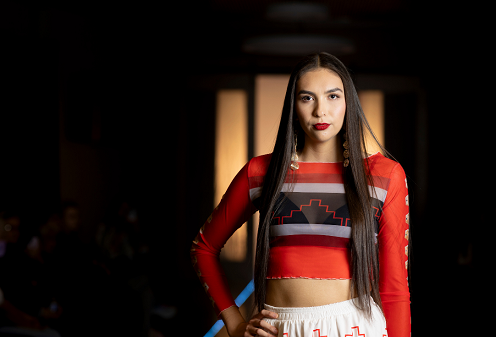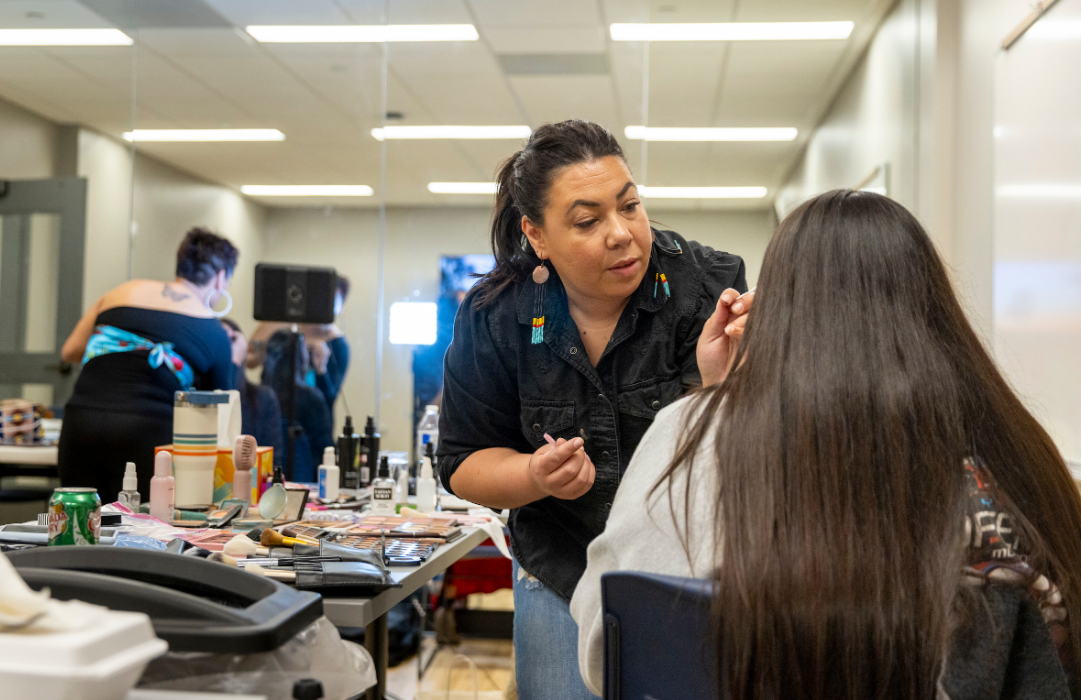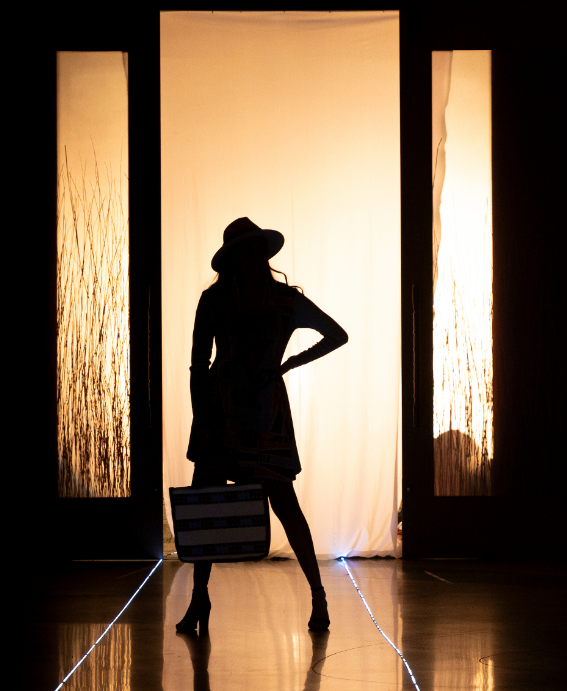
- Details
- By Diana Setterberg, MSU News Service
BOZEMAN, Mont. – An Indigenous fashion show that drew a standing-room-only crowd to American Indian Hall at Montana State University was the perfect backdrop for a celebration of cultural tradition through the lens of modern art, say organizers of the successful Native American Heritage Month event.
“It was such a positive place to be,” said Riley Werk, a sophomore majoring in English education, who helped organize the Nov. 13 show. “Not a lot of people, even in Indian Country, have seen a fashion show like this.”
Werk is part of the three-person cultural outreach team in MSU’s American Indian/Alaska Native Student Success Services. Together with cultural outreach specialist La’Trell Hendrickson in MSU’s Department of Native American Studies, Werk and fellow student-employee Watson Whitford conceived the idea for the show and worked since the start of the semester to make the event happen.
[Editor's Note: This article was first published by Montana State University News Service. Used with permission. All rights reserved.]
“We started talking about a fashion series that includes workshops to make ribbon shirts and ribbon skirts because the Native fashion industry has become one more way of showcasing Native art,” Hendrickson said.

The team reached out to two professional Indigenous designers, both MSU alumni and members of the Crow Tribe: Angela Howe of Choke Cherry Creek Designs and Brocade Stops Black Eagle of Brocade Designs. They agreed to provide the clothing for the show, so Werk set about recruiting models. Meanwhile, Whitford, a freshman majoring in plant biology, began inviting Indigenous design vendors from tribes around and outside Montana. Thirty-five mostly student models representing every Native American nation in the region and several vendors of Indigenously designed wares – including earrings, clothing, cosmetic items and beadwork – signed up to participate. Some vendors traveled from out of state to attend.
On the night of the show before a diverse and appreciative crowd, each model struck a couple of poses in silhouette behind a white sheet before striding down the catwalk. Werk said that, for many of them, the experience not only boosted their confidence but also opened their eyes to future possibilities in the fashion business.
“Many students are interested in the fashion industry. This gave them an opportunity to be photographed, and that work can go into a portfolio,” Werk said. “The designers opened their arms to students’ entrepreneurship questions. It’s opening doors.”
Whitford said he learned a lot about negotiation and working with people to figure out how to accommodate their needs and to encourage nervous models to exhibit confidence on the catwalk.
“I’m proud of everybody,” he said. “To have these opportunities opens more doors and more paths.”
Above all, the organizers said they felt gratified when their goals for the project were fulfilled.

“Our main vision was to have people see our culture portrayed in a modern light,” said Werk. “The environment was a completely safe space where everyone was encouraging and positive.”
Whitford added that the fashion show was the perfect way to bring the Native American cultural perspective into a modern, Western institution.
“People who don’t know about Indian community think we live in the past, but we are modernized people with different ways of incorporating our culture into modern styles of fashion or architecture,” he said. “We can’t live in the old ways, but we can’t live in the totally modern world or we’ll forget who we are.
“It’s healing, these different things we have,” he said. “I hope we continue doing these things for the community and show that we’re proud and make people feel included.”
Help us ensure that the celebration of Native Heritage never stops by donating here.
Help us defend tribal sovereignty.
At Native News Online, our mission is rooted in telling the stories that strengthen sovereignty and uplift Indigenous voices — not just at year’s end, but every single day.
Because of your generosity last year, we were able to keep our reporters on the ground in tribal communities, at national gatherings and in the halls of Congress — covering the issues that matter most to Indian Country: sovereignty, culture, education, health and economic opportunity.
That support sustained us through a tough year in 2025. Now, as we look to the year ahead, we need your help right now to ensure warrior journalism remains strong — reporting that defends tribal sovereignty, amplifies Native truth, and holds power accountable.
 The stakes couldn't be higher. Your support keeps Native voices heard, Native stories told and Native sovereignty defended.
The stakes couldn't be higher. Your support keeps Native voices heard, Native stories told and Native sovereignty defended.
Stand with Warrior Journalism today.
Levi Rickert (Potawatomi), Editor & Publisher

